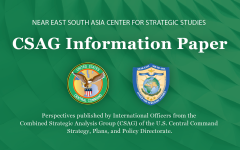CSAG Strategy Paper: Central Asia – Challenges and Opportunities for Regional Stability
April 23, 2024 2024-04-23 16:42CSAG Strategy Paper: Central Asia – Challenges and Opportunities for Regional Stability
CSAG Strategy Paper: Central Asia – Challenges and Opportunities for Regional Stability
CSAG STRATEGY PAPER
Identity withheld in accordance with partner nation agreement. (CSAG/CCJ5)
17 April 2024
Overview:
Central Asia stands at a critical juncture, subject to influence by various global powers and regional actors. The strategic landscape is characterized by a delicate balance of interests, including those of the United States, Russia, China, and the European Union.
The region’s stability is crucial not only for its own development but also for broader international security. Challenges such as political instability, economic disparities, security threats, and competition among external actors shape the region’s dynamics. By engaging with regional stakeholders and international partners, a strategy focused on Central Asia can contribute to peace, security, and prosperity in the region.
This paper aims to briefly analyze the most urgent challenges to the stability of the region and substantiate the thesis that the current situation in Central Asia requires the United States and their key partners to reconsider/adapt their current approaches to maintaining influence in the region and focus on sustainable development. The region of Central Asia, when examined through its strengths, weaknesses, opportunities and threats, is too important to neglect. The numerous challenges of the region, especially in the aftermath of Russian invasion of Ukraine in 2022, may also bring opportunities for its development and taking a greater role in ensuring regional security. The global focus on the Middle East after the events of Oct 7, 2023, in Israel seems to overshadow the ongoing developments in Central Asia.
Key Points:
- Central Asia’s strategic location and vast resources are too important to neglect and are worthy of long-term investments in modernization, integration, and development.
- Challenges serve as drivers for closer integration of the Central Asian countries, especially in the economic, security, and environment protection spheres.
- The Russian invasion of Ukraine deteriorated Moscow’s image of a security guarantor in CAS. Nevertheless, Russia and CAS continue to maintain economic ties due to proximity and shared culture.
- To advance economic and geopolitical goals, China is focusing on expanding its transportation network beyond its borders through the trans-Caspian rail and transport route through Kazakhstan, Azerbaijan, Georgia, and Türkiye (Belt and Road Initiative).
- Central Asian states updated strategies for socio-economic development favoring further cooperation with the U.S. and the EU.
- The factor of increasing ratios of young generation in Central Asian countries with less ties with Russia could be exploited and lead to more active investments/general engagements with the aim of forming an emerging middle class oriented towards the United States.
View other USCENTCOM Combined Strategic Analysis Group (CSAG) papers here.
The opinions and conclusions expressed herein are those of a number of international officers within the Combined Strategic Analysis Group (CSAG) and do not necessarily reflect the views of United States Central Command, not of the nations represented within the CSAG or any other governmental agency.



